040: Digestivo: the Next Generation
Forty weeks of this nonsense and nary a Homecoat to show for it
(SB) Howdy, lovely readers. It’s time for me to once again congratulate us for making it through another week. Unsurprisingly, it has been a weird one, replete with more surprise snow, hints of springtime light, and the ever-eerie approach of New York City’s lockdown anniversary. In case your information silo is different than mine, you may have missed news of horrific violence enacted against Asian American elders, accompanied by statistics about a sharp increase in violence against Asian Americans throughout the course of this year. These reports have also prompted a new chapter in a public reckoning over the place of Asian America in the American racial tapestry. You might have seen calls to imagine alternatives to policing as a response to violence, mutual aid safe-walk networks being established, reminders about how police violence directly impacts Asian American communities, and a great deal of frustration about the silences of major media outlets in covering these stories flitting across various platforms.
As a member of the expansive and shifting coalition that is Asian America, I am invested in these conversations. Though the violence of the past weeks has been focused on those who appear East Asian, it is all too clear to those who have lived through the post-9/11 years that this is yet another opportunity for our fraught and fragmented coalition to learn from the experiences of others. It has also been a moment for thoughtful reflection about the nature of being racialized as Asian in America. I was particularly moved by Kathleen Hou in The Cut and Anne Cheng in The Times. Both gave voice to something that I have often felt but rarely know how to articulate: the loneliness of being told that you have misunderstood your own experiences because they disrupt or complicate the binary logics of an inherited home. (JS: At the risk of playing with fire, are we tuned into the current conversations surrounding Instagram’s self-appointed Chinese culinary gatekeeper?) I thought a lot about this poem.
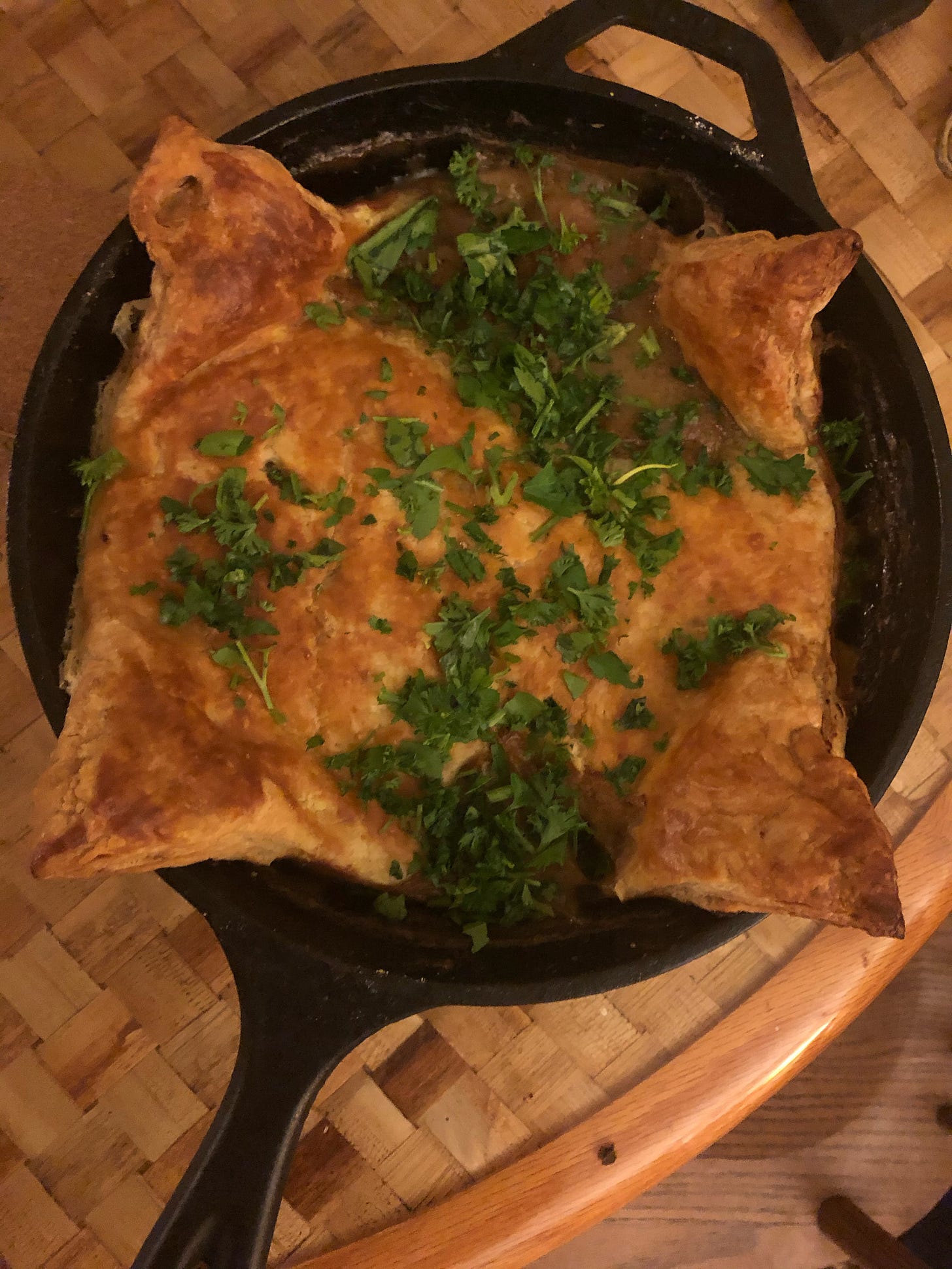
It is perhaps because of this context that I could not help but notice an insistent omission in the discourse about Reply All’s Test Kitchen podcast. Gimlet recently announced the departure of producer PJ Vogt and host Shruthi Pinnamaneni from their duties following a series of Tweets from former coworkers about the ways that members of the Reply All team (particularly Shruthi and PJ) had been partially responsible for many of the same toxic behaviors that they were now exposing at Bon Appetit. This revelation was, of course, disappointing: my group chats have been rife with testimony about how cathartic The Test Kitchen was, how it functioned as an overdue acknowledgement of years of muted slight and workplace trauma we had left unprocessed. In these conversations, many of us confessed that recognizing our own experiences in the stories in Test Kitchen had made us cry.
It has also been disappointing to recognize a familiar and slippery erasure of the complicated dynamics of both race and power in how we are beginning to tell the story of Gimlet as a workplace. In observing how unionization efforts at Gimlet were ugly, journalists and commentators have highlighted the ways that people with (hard and soft!) power like Shruthi and PJ shut down (often cruelly) the efforts of more vulnerable employees – in many cases people of color. This is, no doubt, a familiar dynamic to many of us who have fought for a union within our own workplaces, and would be an easier story to summarize without the thorny fact of Shruthi’s own identity as a woman of color. I bring up this detail not as exculpatory evidence or righteous defense, but as a piece of this story that complicates it. The analysis I’ve read frames the story of Gimlet as simply one of whiteness working against calls for racial equity and diversity. In the broadest sense, this is true. However, in relying on this framing without explicitly naming that Shruthi Pinnamaneni is indeed a woman of color working against unionization, we tacitly participate in affirming the model minority myth that renders Asian-ness invisible as a racial category and experience and leave unchallenged the lingering and unspoken subtext: of course she did, Asian complicity is real, Kamala Harris is a cop. Allying with whiteness and working in service of its goals does not evacuate a person of their identity, but it does complicate the way we understand how race might operate in tandem with power and capital.
Our failure to properly make place for nuance sets us up for failure when interrogating some more complicated questions: how does race function across uneven differences? What are media companies attempting to accomplish when they bring in South Asian employees as an answer to Black grievance? How can we have a more complicated conversation about power and the way it incentivizes silence rather than solidarity without naming the particularities of a circumstance? Can we hold someone like me (OK, a little self aggrandizing here), Shruthi, and Priya Krishna together, both in tension as three different South Asian American women with our own individual political commitments and also as three women who nonetheless get grouped together and held accountable for each other's failures and successes? Do we have language for the particular pain of realizing that someone you assumed was an ally, based on a shared identity, is working against your cause, or more complicated yet, may have materially compelling reasons to do so? I can’t help but feel that we are doomed to useless PR statements, band-aid solutions, and divide-and-conquer labor management techniques until we develop a facility with having those uncomfortable and complicated conversations with each other.
In the meantime, here’s what I ate this week:
Alison Roman’s skillet chicken pot pie, with extra peas and a little bacon grease. S/o to Jake for the recommendation.
Sue Li’s lemony shrimp and white bean stew; simple, swift, and delicious.
Risotto, freestyle. I started things off with onions and a mixture of shiitake and button mushrooms and threw in some slow-roasted butternut squash puree towards the end. I also finished with both shredded gruyere and parmesan because I cannot be tamed. This is your sign to freestyle some risotto ASAP.
(JS) Well, despite not yet having listened to the second episode of The Test Kitchen, my co-editor has once again left me banging my fists on the table in agreement, feeling a unique combination of frustrated and impassioned, with lots to read up on and much more to think about. It’s a strange time for aspiring F&B adjacent folk like myself to try and pivot from the ivory tower of academia into an industry that’s seemingly been rotting from the root. Her conclusions in particular remind me of discussions we’ve recently entered in my own workplace, spearheaded by friend of the newsletter Sarah, regarding power, democracy, dialogue and debate, particularly in the museum space; how can we productively engage with conflict that’s so frequently avoided in order to enact systemic change, rather than presenting a a shallow sense of social cohesion that’s doomed to fall apart? What sorts of protections are necessary to make that conflict productive and ensure a space for open and honest conversation? As you may have guessed from this evasive and generally superficial excuse for an introduction, I do not have the answers! As you may have noticed I frequently use this space primarily as a way to share a roundup of my favorite recent TikToks, but I’m honored to share this newsletter with someone with nuanced perspective and conviction, in addition to a curiosity in the kitchen.
My brain has felt empty but my stomach remains full, thanks to the following recipes:
Quickly hopped on the birria bandwagon, following this recipe from Josef Centeno adapted by Tejal Rao (in lieu of bone-in beef shoulder, I used a roughly 50/50 mix of lamb neck and boneless chuck); I had planned to try Tejal’s birria ramen, but I literally could not stop eating quesabirria tacos until I sadly ran out of leftovers
The Lee Brothers deviled crab, formed into cakes which are baked rather than fried
Banh dau phong a la Doris Ho-Kane, Vietnamese gluten-free peanut cookies rolled in sesame seeds and fried rather than baked
GLD: Soba Boro
(SB) A few weeks ago, inspired by my brief (but thrilling) interest in recreating Erewhon prepared foods, I bought a bag of buckwheat flour. Unfortunately, it seems that the appeal of raw vegan pizza begins to decline precipitously from the moment you step outside of coastal Los Angeles and it is not one of the few foods that is appealing in the freezing-outside, tropical-inside steam-heat microclimate of my apartment. Disheartened by my misadventures in baking bread (an oven thermometer is on the way), I had nonetheless begun to browse the wealth of buckwheat-curious confections around the internet. While chocolate chip cookies and brownies abounded, as did various gluten-free options, I was soon captivated by a more modest cookie: the soba-boro.
Like many of my favorite foods, soba boro cookies are thought to be the product of early Portuguese trade with Asia (“Cancel Me!” she screamed, into the void): soba is Japanese for buckwheat, while boro stems from the Portuguese “bolo.” Based on some very basic research, the term “boro” refers to a wide variety of rustic, round cookies, including the extremely intriguing tamago boro, which you can buy mass-produced bags of. Soba boro, which are often loosely translated on the internet as “Japanese brown sugar cookies” or “buckwheat cookies,” are traditionally cut into the shape of sweet flowers. Chihiro’s recipe, which I used, employs an extremely chic feline cut out instead. I do not own cookie cutters, and used bodega glasses to make circles.
Having wrestled anxiously with large quantities of bread flour for much of the weekend, these soba boro were a dream: First, melt some butter (better yet, brown it) and set it aside to cool. Combine an egg with some light brown sugar and whisk until creamed. Then, mix in buckwheat flour, all-purpose flour, and baking soda with a wooden spoon until evenly incorporated. Slowly drizzle in the butter, and knead until everything coheres into a dough. Mine felt sandy, the recipe calls for “tacky” dough. Wrap the dough ball in some Plastic wrap and refrigerate for at least a couple of hours. When you’re ready to bake, split the dough in half and roll until about 1/8th of an inch thick. Cut out shapes to bake on a silpat or parchment lined tray at 350 for about 10 minutes. The cookies come out almost spongey, but quickly crisp around the edges once cooled. To me, they tasted somewhere in between a biscotti and a sable: chewy, nutty, and airy without pretense. I’m calling them “snack cookies,” easy to reach for while roaming my apartment between calls.
Not All White Meat: In Support of Turkey Breast
(JS) Contrary to what this newsletter might otherwise suggest, lunches ‘round these parts are not an especially elaborate affair. More often than not I’m simply reheating letting leftovers come to room temperature and then diving in, or otherwise repurposing the previous night’s grains and/or proteins into some sort of salad or “bowl” as the kids are now calling them, likely zhuzhed up with a combination of whatever’s pickling in my fridge and the beloved condiment du jour. To call these meals curated would be generous. Now and again I’ll switch things up with a tortilla or frittata (I sometimes refer to this category as “eggs for days”), but most of the time today’s lunch is yesterday’s dinner redux.
Back when I was working at the museum, a dearth of nearby tasty and affordable options had me on a strict BYO lunch regimen (#tbt to the morning I unwittingly copped $14 overnight oats at Bl*estone L*ne), but I remember a time many moons and many workplaces ago when stepping out to grab lunch was quite fun. Back in 2011 I interned at CA Creative, a budding boutique digital agency run by two incredibly chic women from a loft on Great Jones Street. The gig was unpaid (I was young/dumb/incredibly privileged!), but sometimes they’d treat me to lunch from an upmarket neighborhood spot; my favorite was the turkey sandwich from Torrisi, a beloved Italian joint on Mulberry Street that ultimately spawned the Major Foods empire. Lines for their sandwiches frequently stretched down the block, but fortunately my boss had a contact who remains in my phone as “Jessica Torrisi,” providing us a direct line to white meat gold. This is not the space to unpack the current status of Major Foods or its patrons; what’s important is that this sandwich opened my eyes to the simple pleasures of a well-cooked turkey breast, a cut all too often neglected, save for smaller Thanksgiving affairs.
Torrisi published their recipe a few years ago, much to the delight of former unpaid interns comme moi, and much to the horror of those trying to cut down on their BPA encounters. To maximize on moisture and flavor, the recipe calls for brining a couple breasts in salt and sugar overnight, then thoroughly wrapping them in a two-layer getup of plastic and aluminum to roast in a low oven for a couple hours. Once the meat has reached 135, the breasts are plunged in an ice bath, patted dry, brushed with a roasted garlic, honey and thyme-flecked glaze, and blasted at high heat until golden. The finished product is superbly flavorful, a far cry from the dry and bland associations the cut tends to evoke; the method was clearly developed for a restaurant kitchen producing restaurant quantities of turkey breast. I’ve followed the directions to a tee and thoroughly enjoyed the result, but even with certified food service plastic wrap, there’s a small but nagging especially Goop-y part of me that wonders what sorts of toxins are seeping into my slow-roasted meat. (SB: This product contains chemicals known to the State of California vibes.) Fortunately a little poking around in the comments section on the Food52 version of the recipe led me to simplified home cooking directions from an aptly named Karen: “Brine and dry. Place turkey breast in a lidded roasting pan, large casserole or dutch oven. Slow roast as directed. Take lid off, slather on glaze, finish roasting as directed.”
The original Torrisi sandwich paired their supreme turkey with shredded iceberg lettuce, sliced tomato, and a spicy mayo (I’d venture Calabrian chili was involved?), but I would encourage you to take this turkey to new destinations. It would work wonders in a reuben, and there’s no question it would make for an excellent club; if you’re feeling fake healthy you could forgo the bread altogether and add it to a Cobb salad, alongside bacon, hard boiled egg, and blue cheese. Inspired by my co-editor, I most recently tucked some turkey into a slice of Apt. 2 sesame focaccia, topped off with carrot, cucumber and cilantro slaw and a swipe of gochujang mayo, for a lunch that was pleasantly reminiscent of Vanessa’s sesame pancakes.
Sourdough Diaries: Pan de Coco
(SB) Those who have been reading this newsletter for a few weeks will know that I have begun a humbling journey into baking bread. I would like to preface this feature with a note that I am choosing to share my baking missteps in this newsletter moving forward, because vulnerability is important (maybe, also, my brand? yuck); too much flour has been spilled to not result in some writing, and perhaps you care to throw some advice my way. Many of you, sympathetic to my starter troubles and anxieties, recommended reading Bryan Ford’s New World Sourdough, an exciting and compelling cookbook that encourages readers to adopt an intuitive, experience-driven, trial-and-error method for baking bread. This week, I was delighted when my NYPL hold was released, and I could pore over this compendium of recipes that are informed by Ford’s time in New Orleans, Honduras, and Latin American bakeries across Miami. Despite feeling mightily discouraged by my lackluster and crunchy focaccia, I allowed myself to be hopeful about my rapidly doubling starter, which has begun to smell like bananas and success! Emboldened and intrepid, I spent a few hours hunting for an oven thermometer around Inwood before accepting defeat, ordering one online, and resolving to try just one more bread recipe before it arrived.
Moved by a great deal of Instagram testimony, I decided to attempt Ford’s take on pan de coco. While the book features a recipe for chocolate pan de coco, I started with a plain version on his website. Like many sourdough recipes, this one begins with building a levain which is then mixed into warmed coconut milk and water, releasing an aroma that took me immediately back to the Kerala kitchens of my youth. The dissolved levain is kneaded together (briefly) with bread and AP flours, a little sugar, and shredded coconut and left to rise for several hours before being shaped into little bolas. These then proof in a loaf tin for a couple hours at room temp or several in the fridge. When ready to bake, the proofed dough is basted with coconut oil and topped with more shredded coconut. Ford recommends pre-heating your oven for at least 30 minutes at 375 and baking your bread for about 40, or until golden brown. He also notes that pan de coco is best enjoyed hot, and his page offers many steamy instagram bun-reveals to prove it.
Still mastering the art of being #present and #intune with my bread, I allowed my pan de coco to do its bulk fermentation on the counter and final proof in the fridge while I slept. My initial shaping was clumsy, and I would have been wise to take more care strategizing about my dough-division technique: my bolas were uneven and took extra coaxing to cohere. I also obviously have no idea what temperature my oven is, because 40 minutes at 375 left me with bread that was a little raw at the center. Determined to prevail, I tented my loaf with tin foil and returned it to the oven for almost forty more minutes. While the pan de coco that came out of the oven was denser than many of the grams lead me to believe it should have been, it was indeed very tasty: tangy, a tiny bit sweet, with a pleasant crust and doughy interior. I enjoyed it hot with kaya jam, the next day dipped in nutella, and will likely be repurposing any remaining leftovers for some sort of bread pudding. All in all, it wasn’t perfect, but it wasn’t bad. And I guess that’s just where I am with bread right now.
PERMANENT ROTATION: Maybe this is obvious, but at forty weeks into this thing we felt that everyone could use a reminder this classic Marcella Hazan butter and tomato sauce exists, and you likely have everything you need to make it.
WISH LIST
(SB) I have found myself somewhat obsessed with Midnight Diner on Netflix (it’s comforting! It’s sweet! It makes me feel safe and also hungry!) and as a result have been coveting a tamagoyaki pan. Do I need another pan? No! Do I want this one? Yes!
(JS) A job hahahaha!!! Manifesting!!! Also I just found out my community garden offers compost drop-off so I guess I might channel my inner garbage monster into becoming a compost queen? Send me your chicest (and most odor-reducing) compost bins please!
(SB & JS) Have we told you about our obsession with Off Hours’ Homecoat? Full disclosure, we somehow still don’t own them, but we’re currently fawning for their “dogwalker” edition (not to be confused with JS’s previous wish for an Entireworld dogwalker coat; shoutout sister of the newsletter Sam for coming through last Hanukkah). Does anyone have a PR contact at Off Hours? We’re desperate to shill.
Follow us on Instagram for extra fun treats, including extremely #honest and incredibly #unfiltered product reviews!


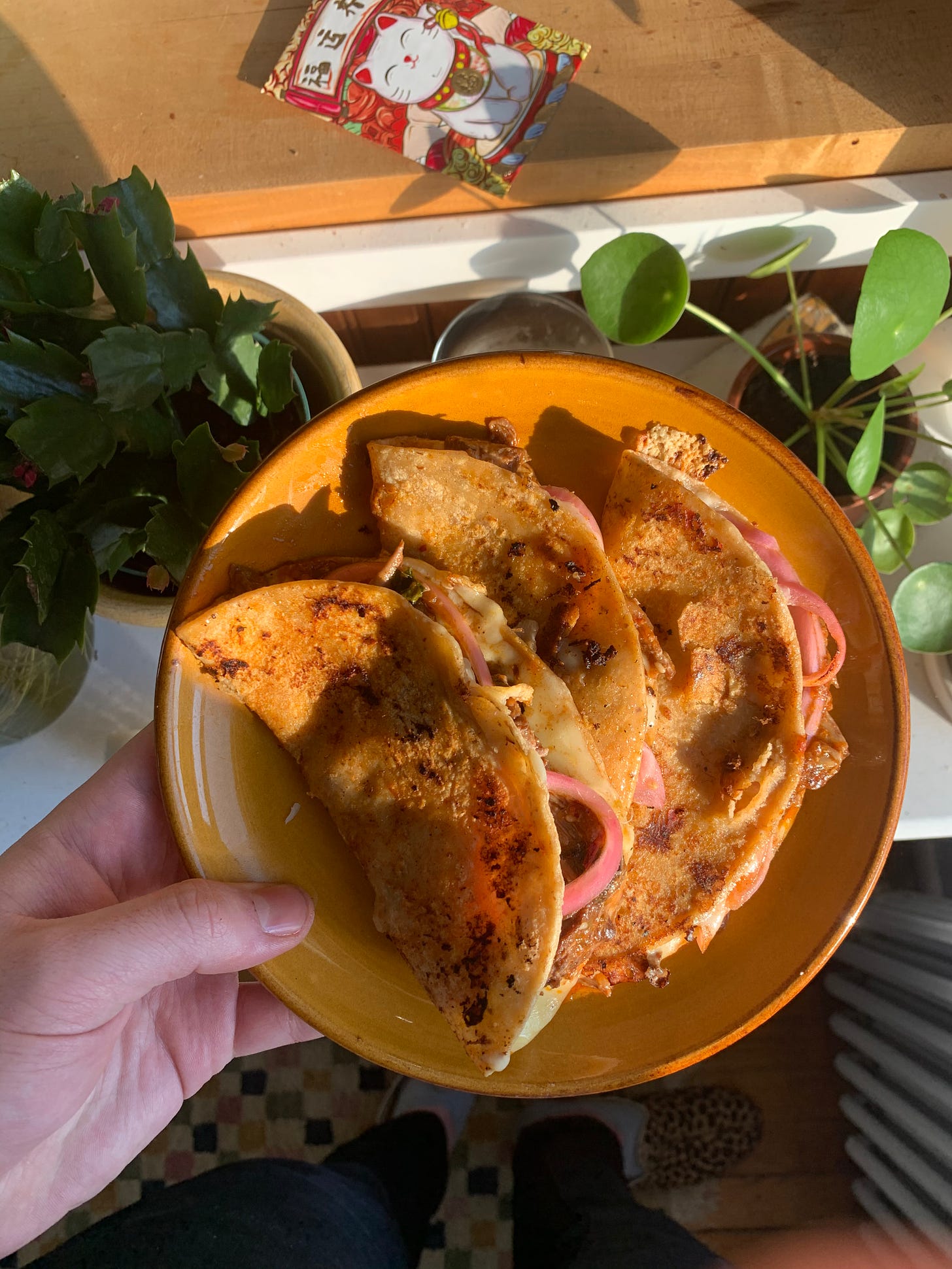
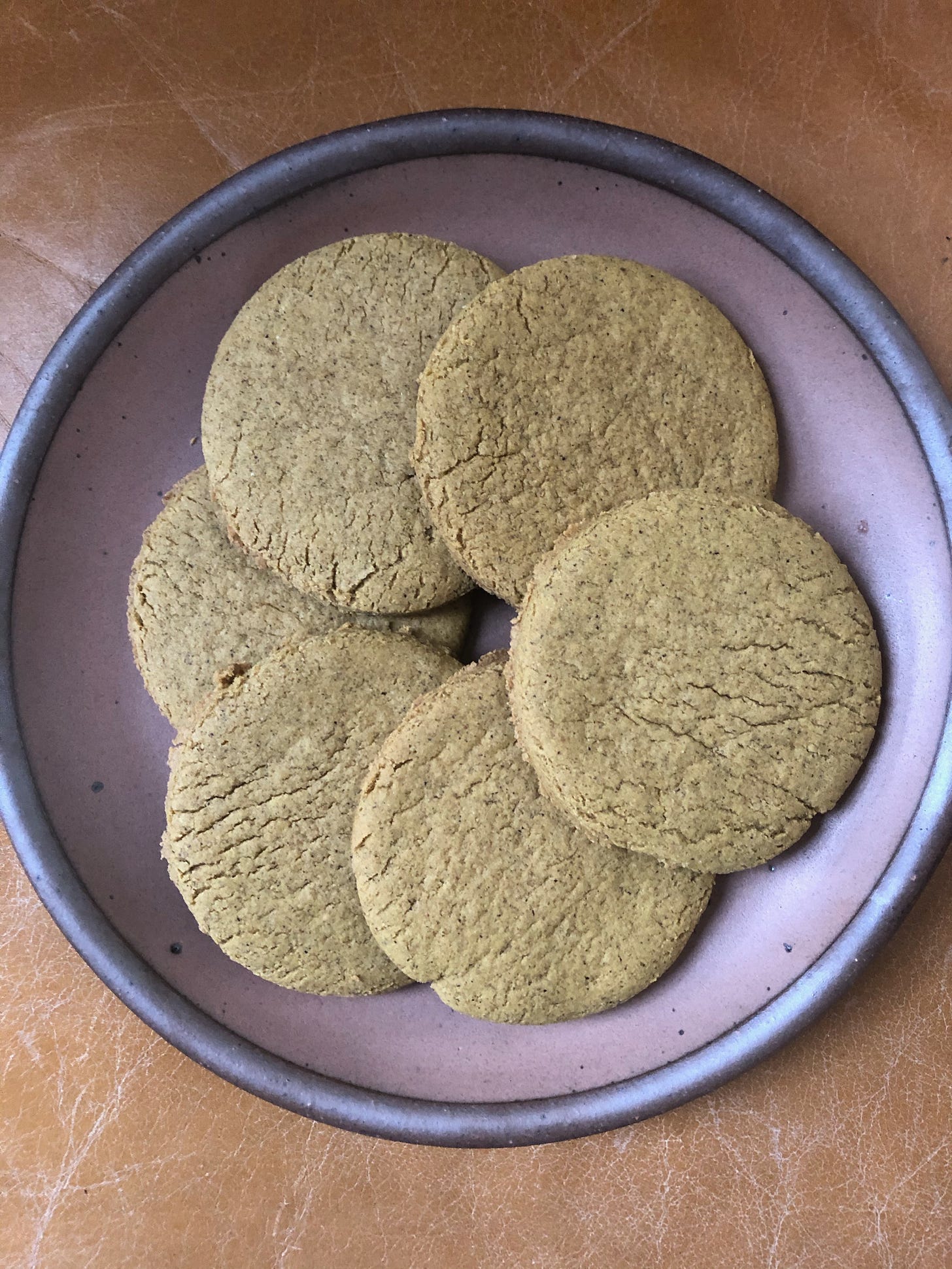
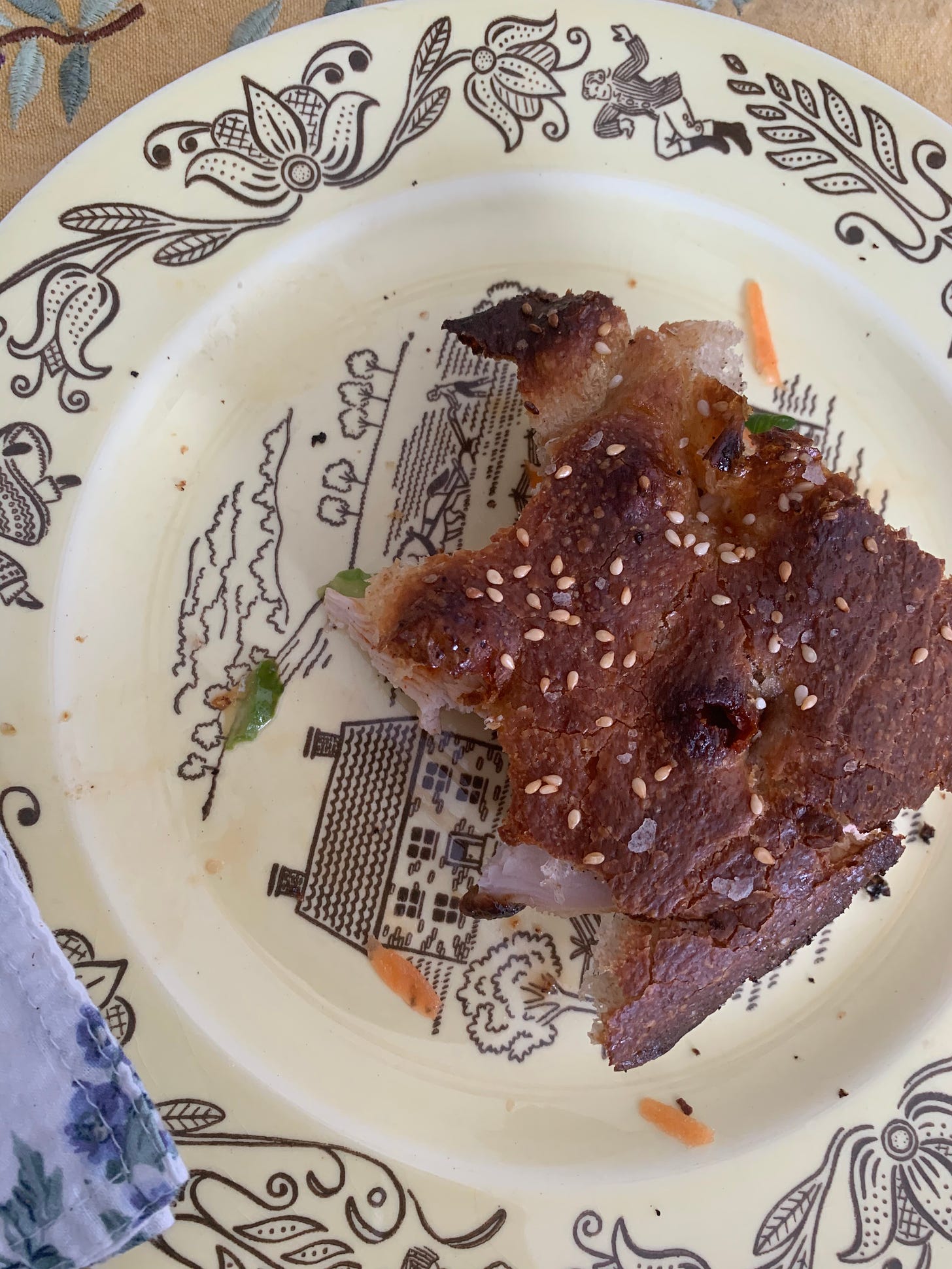
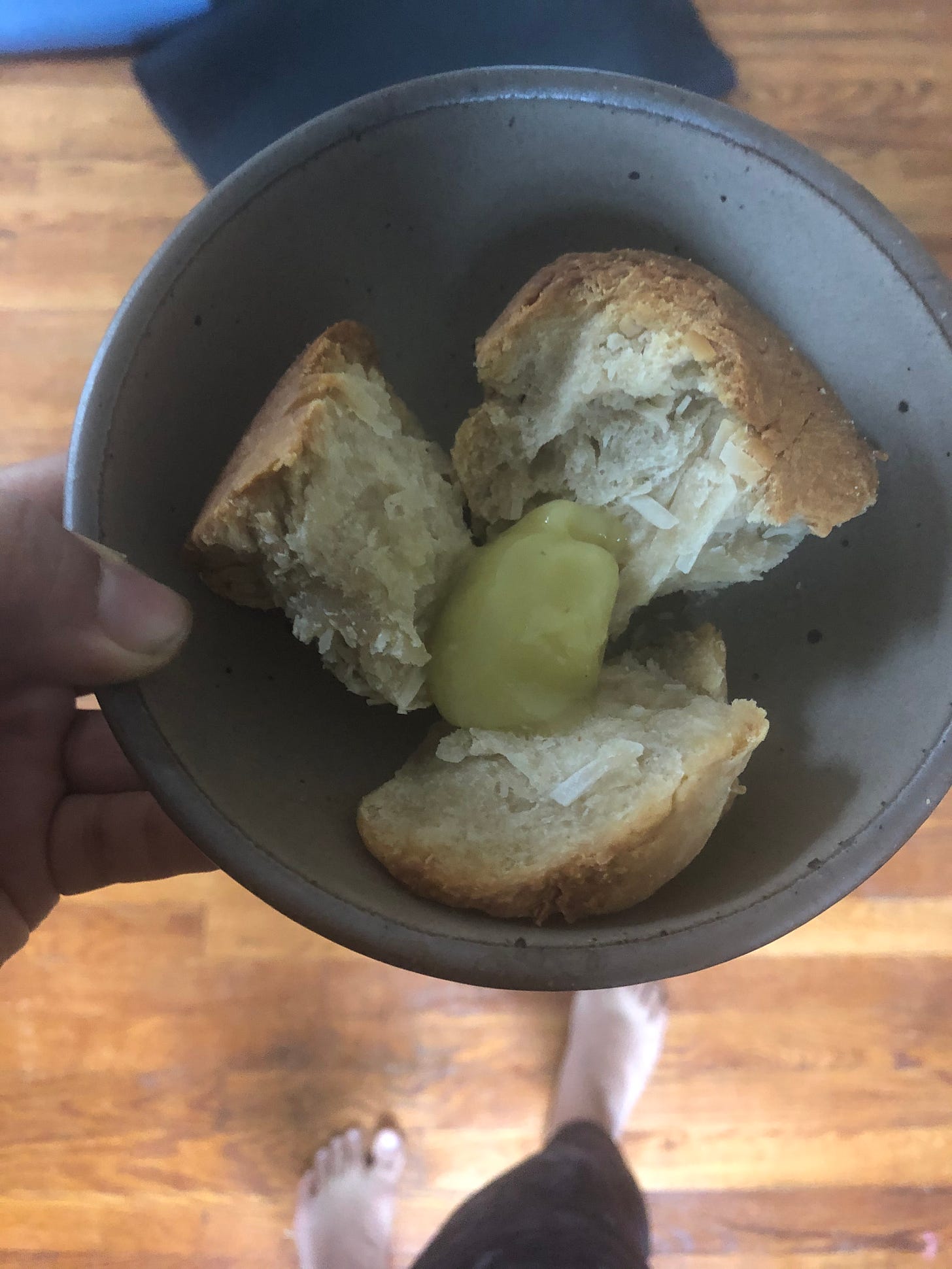
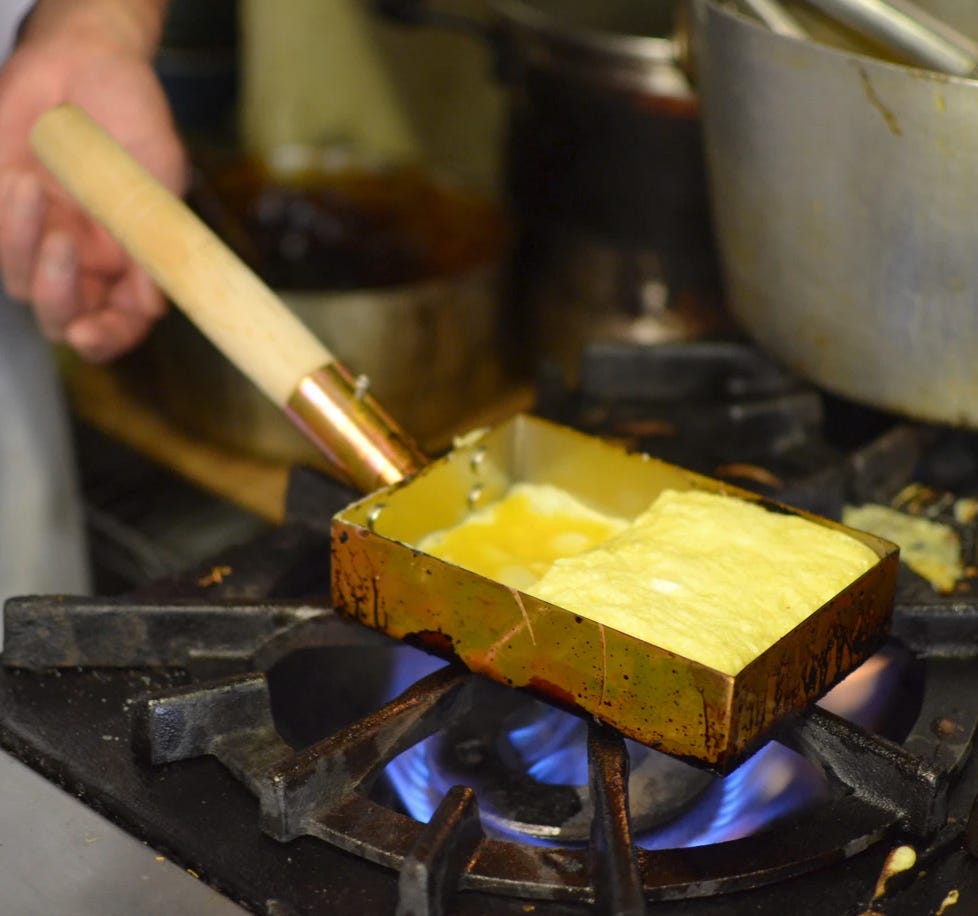


Congratulations on 40 weeks of this delightful and thoughtful project. It is comforting to read political analysis based in solidarity, empathy and the struggle for justice and then be grounded with a "what I ate this week list ". I have enjoyed every morsal of it and look forward to more. -matilda